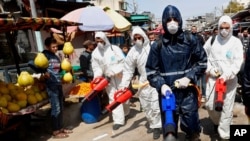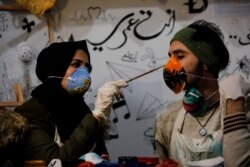For a few short weeks, the people of Gaza had hoped that 13 years of tightly sealed borders with Israel and Egypt might somehow prevent the spread of COVID-19 into this Palestinian enclave of 2 million people.
“Some even joked that the Israeli blockade of Gaza protected it from the virus,” Raeed Redwan, a 25-year-old graduate student at Al-Azhar University, said. “But now the people are filled with fear.”
Redwan said the shift of feelings from immunity to vulnerability came Sunday after authorities announced that two men, aged 79 and 63, who returned to the strip from Pakistan via Egypt, tested positive for COVID-19 at a border quarantine station.
Authorities now count 59 cases of COVID-19 in the West Bank and Gaza Strip. Israel has more than 1,440 confirmed cases.
“Gaza is amongst the most densely populated places in the world, and social distancing is very difficult,” Abu Salem said. “This is a terrifying scenario.”
Since March 15, more than 2,000 Gazans who crossed the Rafah border with Egypt and the Erez crossing to Israel have been put in home quarantine.
An additional 1,200 have been put in quarantine facilities built by the local health authorities adjacent to the two frontier checkpoints, World Health Organization officials said.
“What we need to do is strengthen the capacity of the health system because should we see an increase in the number of cases, some of them might require respiratory treatment,” Dr. Gerald Rockenschaub, head of the WHO’s office for the occupied Palestinian Territory, said. “Funds have been released to scale up and procure needed supplies and equipment.”
Gaza doctors worry it may be too late in the game against coronavirus for their health system’s medical procurements.
“As far as I know, we haven’t received anything from the Egyptians or the Israelis, and we have only a limited number of testing materials supplied to us from the [Palestnian] Ministry of Health in Ramallah [The West Bank],” Ayman Halabi, director general of labs and blood banks for the Gaza Ministry of Health, said.
“What came to us is very limited,” Halabi said. “We estimate that once the virus arrives in full force, we will need 7,500 surgical masks a month, and all we have is around 1,000.”
“I know that some high school kids and university students have started watching online videos to teach themselves how to make masks,” Halabi told VOA. “But we need to have personal protective gear that meets medical standards for the staff who work in labs, hospitals and quarantine centers.”
Gaza’s schools closed March 5, after Palestinian President Mahmoud Abbas declared a 30-day state of emergency.
But the Hamas-run Religious Affairs Ministry in Gaza waited until Tuesday to close all mosques in the coastal enclave.
Mkhaimar Abusada, a political scientist at Al-Azhar University in Gaza, said local Hamas leaders were reluctant to be seen as following directives from the rival authority run by the Fatah movement in Ramallah.
“Initially, they saw the declaration of a state of emergency in a critical light, and they said that with Allah’s help, there is nothing to fear,” Abusada said.
“That changed when they [Hamas leadership] started looking at the [infection] numbers coming from Italy and Spain, and they started to think, well, this is not a joke.”
Abusada and others said the two men diagnosed Sunday are Islamic clergy members close to the Hamas establishment.
Last Thursday, Hamas leader Yahya al-Sinwar and Rawhi Mushtaha, a co-founder of the group’s armed wing, the Izz al-Din al-Qassam Brigades, inspected construction of the quarantine unit that Gazan authorities have set up on the border with Israel.
Palestinian media is reporting that Tawfiq Abu Naim, head of security forces in Gaza, and his deputy have been in quarantine since Sunday, with some sources indicating the two were in proximity to the clerics who tested positive for the virus.
On Saturday, the Religious Affairs Ministry called for the immediate cancellation of all mourning gatherings and told community members to refrain from shaking hands at gravesite condolences.
Social distancing is proving a cultural challenge.
“Gaza is so crowded, and when you walk on the street you meet many, many friends and acquaintances, people dislike it when you tell them that you can’t shake their hands for health reasons,” Ramzi Okasha, a 45-year-old high school instructor, said. “They don’t get it yet that it’s dangerous to hug and think it’s rude to avoid proximity.”
Still, Okasha is more concerned with the logistics of maintaining educational programs for the more than 2 million children in Gaza and the West Bank whose schools are shuttered.
“Like teachers everywhere, we are struggling to put lessons online,” Okasha said. “But many of the children don’t have computers, so they are going to the neighbors and extended family to access the lessons. This is also now risky behavior.”
The instructor said that digital bandwidth also seems to have diminished with increased internet use.
“You also have to remember that we only have five to eight hours of electricity a day,” Okasha told VOA. ‘That is bad enough when kids are competing for screen time to watch instructional videos, but it’s going to be tragic when hundreds of people will need 24-hour access to respirators.”






